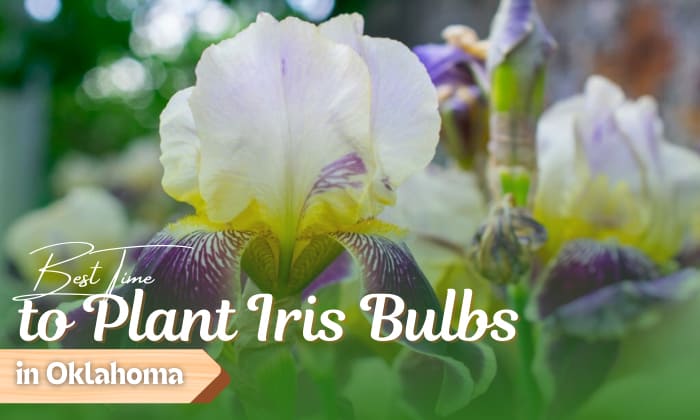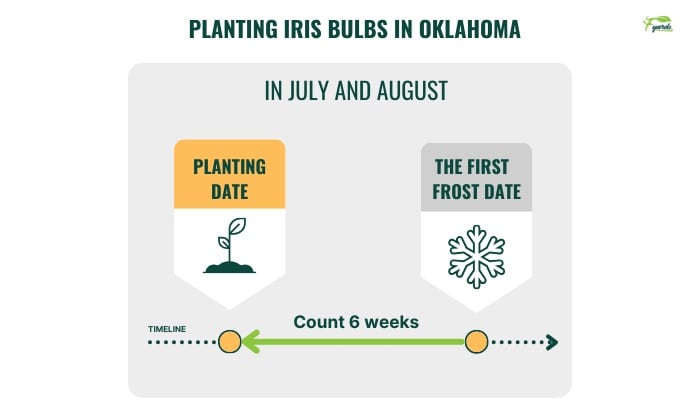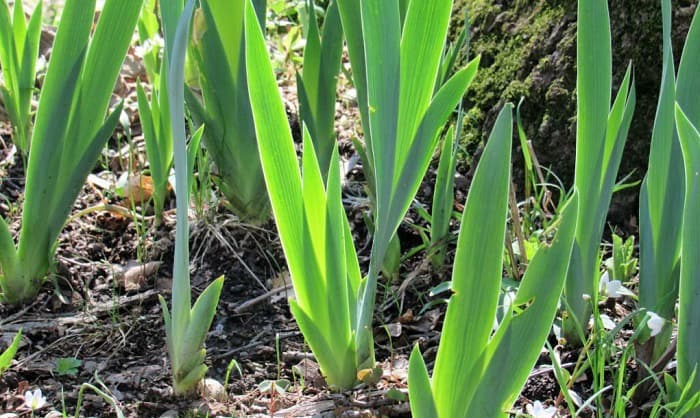Named after the Greek goddess who personifies rainbows, irises are available in showy colors and blossom from February to August in Oklahoma. You only need to grow them in July and August before freezing temperatures arrive.
With proper care, these perennials will last for three to four years before dividing them becomes necessary.
Learn when to plant iris bulbs in Oklahoma and other tips below.
Table of Contents
Best Time to Plant Iris Bulbs in Oklahoma
Irises generally come in two categories:
- Bulb irises: include varieties like Dutch and Reticulata or dwarf.
- Rhizome types: can be divided into crested, bearded, and beardless irises.
Of these flowers, bearded cultivars are the most common in Oklahoma, but you can also grow bulbous iris plants in the state, considering they’re compatible with hardiness zones 5 to 9, and Oklahoma spans zone 6 to 8.
Varieties aside, here is the best time of year to grow irises:
- Sow iris bulbs six weeks before or up to the first frost date. These plants need cold fall temperatures and annual dormancy to bloom in spring.
- Note that you have slightly less leeway when it comes to planting iris rhizomes in your garden. Give this type at least six weeks to adapt and prepare for winter, as they require more time to establish roots.
For those wondering “is it too late to grow irises?” check out the table below.
| Oklahoma Hardiness regions | Average first frost | What month can you still plant irises? |
| Zone 6 | October 31 | September 19 – October 31 |
| Zone 7 | November 15 | October 4 – November 15 |
| Zone 8 | November 28 | October 17 – November 28 |
Tips for Successful Iris Bulb Cultivation in Oklahoma
1. Consider the following iris varieties
- Lady of the Night – Dramatic dark purple flowers with a fan-like shape; have blooms up to three inches in size
- Lotsa Heat – Golden yellow flowers with a spicy fragrance and some pinkish, copper tints
- Marbella – Light lavender blooms with a ruffled appearance; can bloom in partial shade
- May Frost – Predominantly white irises that flower mid-season, these have a very subtle blue shade at the tips.
- My Cher of Happiness – This variety has pink flowers that blossom later in the season. It has a sweet smell and produces eight to nine buds.
2. Satisfy the plants’ growing requirements
Irises need at least six hours of full sun and well-drained soil with a pH of 6.8 for optimal growth. The plants should be twelve to twenty-four inches apart and fertilized with a 6-10-10 formula or another option low in nitrogen.
When sowing rhizomes, dig holes four inches deep, spread the plant roots out, then backfill the dug area before laying the rhizomes on the soil so that they’re slightly above-ground.
As for bulbs, you can plant them up to six inches deep. Unlike rhizomes, they won’t bloom well if the sowing depth is too shallow.
3. Divide and replant overcrowded irises for consistent blooms
A good time to do this task is when rhizomes start to come out of the ground. Divide them with a knife, then discard the old mother plant and keep the young offshoots for re-sowing.
If you have bulbous irises, separate the daughter bulbs from their mother in the fall, then put the new bulbs into a potting mix to help them grow.
Conclusion
Now that you know when to plant iris bulbs in Oklahoma, get ready to order them in July for planting.
Iris societies will have the best varieties for each state they’re in, so avoid purchasing from sellers in other regions, since the cultivars there may not adapt to Oklahoma’s dry and windy climate.

Hi, I am William – Floridayards’ digital content creator. My job is to find answers to all your concerns with thorough research and our team’s expert advice. I will also bring you honest reviews on the best products and equipment for raising your beautiful garden. Please look forward to our work!













